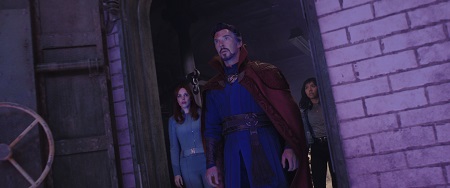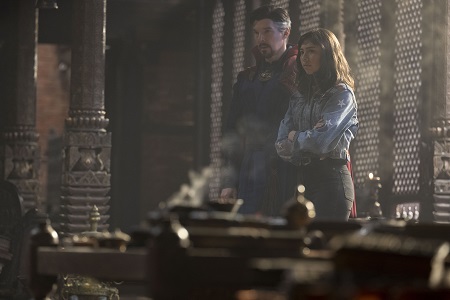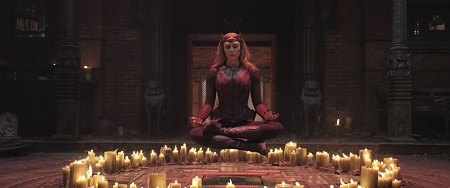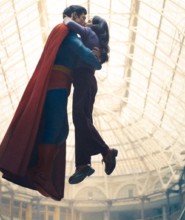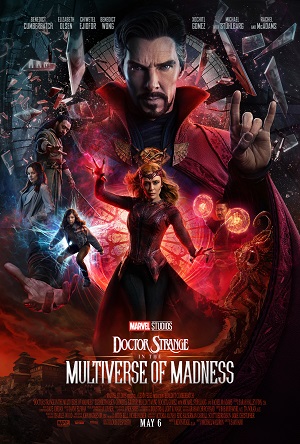
Doctor Strange in the Multiverse of Madness (2022)
by Sara Michelle Fetters - May 4th, 2022 - Movie Reviews
Raimi and Olsen put a Personal Stamp on the MCU’s Multiverse of Madness
Since 2015’s Avengers: Age of Ultron, there have been plenty of celebrated filmmakers who have taken the reins of an entry in the Marvel Cinematic Universe only to find their distinctive style significantly hamstrung by the demands of the sprawling, interconnected storylines engineered by Marvel Studios. There have been others who have notably managed to put their idiosyncratic mark on the material even while having to work under predetermined narrative restraints, but they have been few and far between.
Don’t get me wrong. Most MCU efforts are still divertingly entertaining even with their flaws, and I honestly think the last one that I wrote a mostly poor review of was 2013’s Thor: The Dark World. Even somewhat middling 2021 entries like Black Widow and Shang-Chi and the Legend of the Ten Rings had more positives than negatives; both were just decent enough that, even though neither stands on their own, this isn’t as problematic as it should be.
The issue — one many have been silently grumbling about since 2014’s Captain America: The Winter Soldier — is that few of these motion pictures have been allowed to stand on their own. They all have to spend far too much time setting up events and characters that have nothing to do with their own narratives. They are obsessed with what comes next, and so at a certain point, watching a Marvel movie began to feel more like homework for a forthcoming quiz than it did a goofy, special effects-filled slice of superheroic pop entertainment.
All of which got me to sit up in shock when the studio turned over Doctor Strange in the Multiverse of Madness to a director like Sam Raimi. He’s handled Marvel characters before, of course. His Spider-Man trilogy is a massive, worldwide success that likely set the foundation for the MCU as we know it today.
But those pictures, most notably 2004’s phenomenal Spider-Man 2, had personality. They were self-contained even when they planted the seed for events to be explored in greater detail in future stories. Raimi knew how to work inside the studio system yet still managed to maintain his rebellious Evil Dead-meets-Darkman identity, and this includes the overstuffed Spider-Man 3.
For those thinking this new incarnation of Marvel would neuter the director’s distinctive anything-goes style and bury his exploitation horror-comedy roots in quick-dry cement, think again. It doesn’t happen immediately, but when it matters most, Raimi unleashes all of the crazy, comedically vaudevillian, blood-soaked, visually audacious tricks fans expect from him, and this sequel comes alive like no other MCU entry in recent memory.
What’s interesting is that the director accomplishes all of this inside a film that’s beholden to one television show (WandaVision) and at least three other MCU epics (Spider-Man: No Way Home, Avengers: Endgame, and Doctor Strange) for it to even exist in the first place. Yet, as convoluted and messy as Michael Waldron’s (Loki) screenplay is, Raimi handles things in such a way that a viewer does not need to have watched any of those to understand what is happening here. He shuffles through laborious pieces of exposition with shocking rapidity, highlighting key pieces of information while discarding the superfluous bits that don’t have much bearing on the events central to his main characters or their collective ordeal.
And what are those travails? Doctor Steven Strange (Benedict Cumberbatch) and current Sorcerer Supreme Wong (Benedict Wong) face off against an unexpected adversary when a visitor from the expansive multiverse, America Chavez (Xochitl Gomez), literally drops into the streets of New York and needs them to save her. She’s being chased by a powerful force who wants to steal her abilities to travel through the multiverse for themselves, and they’re willing to rip through anyone — and any alternate realm — standing in the way of achieving their goal.
This leads to a universe-hopping adventure in which Doctor Strange and America are thrust into various alternate realities, the former encountering versions of himself, his friends, and his loved ones in the process. He gets to see first-hand what the dangers of messing with time are. He also experiences the physical and psychological toll of dabbling with the mystical dark arts, the evil magical spells hidden in an ancient book forbidden for good reason.
Other than showcasing a colorful visual palette that’s somewhat abnormal for the MCU, the first act of this sequel isn’t exactly earthshaking. But it’s all a ruse. It’s as if Raimi is setting the viewer up, cleverly giving the audience something purposefully familiar before cagily pulling the rug out from underneath them. Once Doctor Strange and America get thrust into far corners of the multiverse, all bets are off. By the time he’s forced into a corner and has to unleash a plan so gruesomely bold it could wake the dead, it’s clear Raimi has full control, and the folks behind the scenes at Marvel are only along for the ride.
I’m not going into the plot because part of the fun of the malevolent nuttiness of the climax is in seeing how everything plays out free of spoilers. Yes, there are some notable cameos. More importantly, as this is a trip into the multiverse, there are crossover possibilities between Marvel properties that haven’t been feasible for a multitude of legal and studio-mandated reasons until now. Make of that what you will.
I do have to talk about Wanda Maximoff (Elizabeth Olsen), however. Her character, fresh off the events of WandaVision, is the key cog in the plot. The good news? Olsen is spectacular. This is an award-worthy performance. Explosive. Emotional. Three-dimensional. The actress is masterful; the complexity of what she does is well beyond anything I anticipated. Olsen elevates the material every time she’s up on the screen, and a pivotal moment where she gets to portray two different versions of Wanda at the same time is simply stunning.
But there’s a flip side to this coin. Marvel has done a disservice to the character. Even since her debut in Age of Ultron, Wanda’s arc has been nothing but trauma, pain, grief, loss, and then more trauma. While it appeared WandaVision was going to allow the hero time to finally overcome all that’s happened to her and emerge forever changed and personally triumphant, Waldron’s script throws that off a cliff double the size of the one on planet Vormir. Worse, her struggles are utilized to ease the internalized misfortunes of the sequel’s male lead.
This is a problem, and the only reason Doctor Strange in the Multiverse of Madness is able to overcome it is thanks to Olsen’s magnificence and Raimi’s superlative handling of the material during the third act. Together, they put a personal stamp on the proceedings that’s worth celebrating, making this second solo adventure for the master of the mystic arts not just worthwhile, but arguably the first entry in the MCU since Black Panther that could even remotely be considered essential.
– Review reprinted courtesy of the SGN in Seattle
Film Rating: 3 (out of 4)


